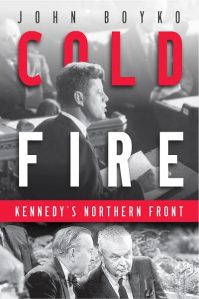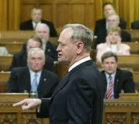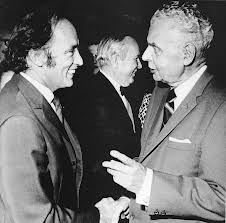At the funeral of a colleague Stephen Harper joked that even his friends don’t like him. Few seem to know him. The public personae is apparently very different from the man. Despite his having been prime minister for nearly a decade, for many Canadians, Mr. Harper remains an enigma. As Canadians enter their longest campaign since the 19th century, it is perhaps an appropriate time to pause and consider how the country’s most public person can remain such a mystery. Maybe the best way to seek an understanding of our inscrutable prime minister and the road down which he is leading the country is to recall three former prime ministers with whom he shares policies, principles and personalities.

Prime Minister Stephen Harper
Mr. Harper’s control of his cabinet, caucus and senior bureaucrats knows few bounds. All appearances, speeches and press releases are vetted to ensure that the government speaks with one voice – his voice. Even the prime minister’s own remarks are seldom extemporaneous while reporters’ questions are always limited and often ignored.
In this way, Mr. Harper reminds one of R. B. Bennett. Bennett was prime minister in the worst days of the Great Depression. Like Harper, he was an easterner who represented a Calgary riding. Like Mr. Harper, Bennett enjoyed a reputation as a skilled political strategist and nearly every member of his caucus rode to Ottawa on his coat tails. Bennett held a similar lock on his colleagues, disdain for the press and a reputation for running a one-man show. A popular joke had a Parliament Hill tourist query a guide about the well-dressed man walking alone and talking to himself and being told that it was the prime minister conducting a cabinet meeting. Bennett used to speak of “his” government like the current PMO refers not to the Canadian but the Harper government. Bennett’s iron control, like Mr. Harper’s, rendered all errors his and all opposition personal.

Prime Minister R. B. Bennett
Mr. Harper also reminds one of Joe Clark. Like Mr. Harper, Clark called Alberta home and was a career politician who entered the profession quite young. They both earned reputations as astute policy wonks. While they both exude obvious intelligence and political acumen both men also often appear uncomfortable in their own skin, walk to podiums as if to gallows and read speeches like they can’t wait for them to end. Many Canadians grew uncomfortable with both, perhaps because they seemed uncomfortable with themselves. This unease could explain why so many people were surprised and bemused when Clark made self-referential jokes about his lack of charisma or when Mr. Harper performed a Beatles tune at Ottawa’s National Arts Center or was seen in a leaked YouTube clip doing clever imitations of past leaders.
The ice in Clark’s manner seemed even colder when contrasted with the fire of Pierre Trudeau for whom magnetism came as naturally as breathing. Alas, another Trudeau is now radiating heat around a man who, like Clark, appears to be an introvert in an extrovert’s game.

Prime Minister Joe Clark
The Prime Minister that is most like Mr. Harper is John Diefenbaker. Like Harper, Diefenbaker was born in Ontario but became a transplanted westerner who made a name for himself by giving voice to the yearning and alienation of a region believing, with some justification, to have been underappreciated and ill-treated. Also like Harper, Diefenbaker behaved like an outsider even when he became the ultimate insider. Both seemed to perceive politics as a contest waged with enemies.
There are other similarities. One of Diefenbaker’s goals was to open the north. Mr. Harper has sought to protect Canada’s Arctic sovereignty while spurring economic development in the vast part of the country that, with climate change changing everything, holds more potential than Diefenbaker could have imagined. Diefenbaker also fought for imperial ties long after the empire was gone, including keeping the Red Ensign as our flag. He would salute Mr. Harper’s re-hanging pictures of the Queen and putting the Royal back into our military while reviving old ranks and insignia.

Prime Minister John Diefenbaker
Diefenbaker spoke of nationalist unity and sought to end hyphenated Canadianism. He called his vision One Canada. Harper holds a similar view of the country. While Diefenbaker rejected and largely ignored Quebec’s ethnic-nationalism, Harper emasculated it by having a bill passed that recognized “the Québécois” as forming a nation within a united Canada. That is, Quebec is not a nation, just those French-speaking people who self-identify as Québécois. The Harper bill channelled Diefenbaker’s pan-Canadian, One Canada nationalism.
Harper’s relationship with the United States was as tricky as Diefenbaker’s but their motivating ideas were similar. Throughout the difficult 1963 campaign in which he was accused of being anti-American, Diefenbaker said that his fight was for Canada and not against the United States. He repeated the point in his memoirs: “It was simple logic that Canada could not maintain its independence if we continued existing Liberal policies. Recognition of this implied no hostility to the United States. It was a case, as it was for many of my government’s policies, of being pro-Canadian, not anti-American.”
Two generations later, on November 19, 2012, Prime Minister Harper answered questions before the Canadian-American Business Council. He echoed Diefenbaker by offering, “We are strong Canadian nationalists who value what is distinctive and unique about this country and think in our own modest way that this is actually a better country. What we’ve tried to do and tried to tell Canadians is there’s no need for true Canadian nationalism to have any sense of anti-Americanism.”
Robert Kennedy once said that of all the leaders with whom his brother interacted, Diefenbaker was the only one he hated. That sour relationship negatively affected cross border relations. President Obama surely harbours no such feelings for Mr. Harper but they are certainly not close and they disagree on many fundamental issues, most importantly, at the moment, is the environment and related issue of the Keystone XL pipeline.
Diefenbaker would not have agreed with everything Harper has done or how he is doing it. Diefenbaker was a man of the House and so would have risen in outrageous anger at the prorogations and other parliamentary parlor tricks through which Harper has bent the rules. Further, like Bennett and Clark, Diefenbaker was a Red Tory and so would have been orphaned in Harper’s party that purged the word Progressive and had the Conservatives become more conservative.
The similarities nonetheless remain. That Harper recognizes his link to Diefenbaker has been seen in the ways he has saluted him. Harper’s government has provided money to update and upscale Saskatoon’s Diefenbaker Centre. When Ottawa’s old city hall building was renovated to house government departments it was renamed the John G. Diefenbaker Building. A new Coast Guard icebreaker will be called the John G. Diefenbaker.
Considering the leaders and ideas of yesterday allows a deeper context within which we can comprehend today and, through seeking our unreadable prime minister, perhaps to better understand tomorrow. Prime Ministers Bennett, Clark and Diefenbaker continue to serve Canada by inviting us to glimpse the road ahead not by peering through the windshield but glancing in the rear view mirror.










